Miele G 865 User Manual
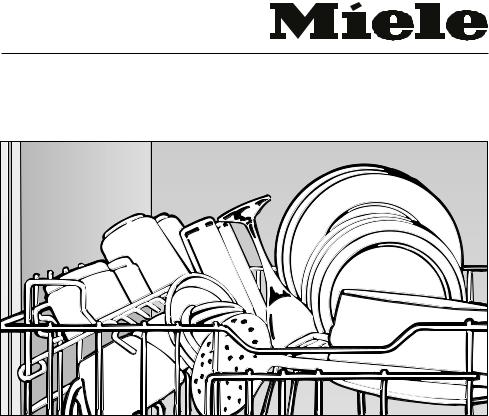
Operating instructions
for the G 865 dishwasher
To prevent accidents and reduce the risk of damaging the machine, read the Operating Manual before installing or using
the machine.
ö
M.-Nr. 05 098 500
2

Contents
Guide to the appliance. . . . . . . . . . . . . . . . . . . . . . . . . . . . . . . . . . . . . . . . . . . . . . 5 View of the machine . . . . . . . . . . . . . . . . . . . . . . . . . . . . . . . . . . . . . . . . . . . . . . . . . 6 Control panel . . . . . . . . . . . . . . . . . . . . . . . . . . . . . . . . . . . . . . . . . . . . . . . . . . . . . . 7 Important safety instructions . . . . . . . . . . . . . . . . . . . . . . . . . . . . . . . . . . . . . . . . 8
Instructions importantes sur la sécurité . . . . . . . . . . . . . . . . . . . . . . . . . . . . . . 10
Caring for the environment . . . . . . . . . . . . . . . . . . . . . . . . . . . . . . . . . . . . . . . . . 12
Before using for the first time. . . . . . . . . . . . . . . . . . . . . . . . . . . . . . . . . . . . . . . 13
Opening and closing the door . . . . . . . . . . . . . . . . . . . . . . . . . . . . . . . . . . . . . . 14 Child safety lock. . . . . . . . . . . . . . . . . . . . . . . . . . . . . . . . . . . . . . . . . . . . . . . . . . . 14
Water softener (Not available in US models.) . . . . . . . . . . . . . . . . . . . . . . . . . . 15 Setting the water hardness level. . . . . . . . . . . . . . . . . . . . . . . . . . . . . . . . . . . . . . . 15 Filling the salt reservoir. . . . . . . . . . . . . . . . . . . . . . . . . . . . . . . . . . . . . . . . . . . . . . 16 Salt indicator. . . . . . . . . . . . . . . . . . . . . . . . . . . . . . . . . . . . . . . . . . . . . . . . . . . . . . 17 Bypassing the Salt indicator lamp. . . . . . . . . . . . . . . . . . . . . . . . . . . . . . . . . . . . . 17
Adding rinse aid . . . . . . . . . . . . . . . . . . . . . . . . . . . . . . . . . . . . . . . . . . . . . . . . . . 18 Setting the dosage. . . . . . . . . . . . . . . . . . . . . . . . . . . . . . . . . . . . . . . . . . . . . . . . . 19
Loading the dishwasher . . . . . . . . . . . . . . . . . . . . . . . . . . . . . . . . . . . . . . . . . . . 20 Loading examples.. . . . . . . . . . . . . . . . . . . . . . . . . . . . . . . . . . . . . . . . . . . . . . . . . 21 Bottom basket. . . . . . . . . . . . . . . . . . . . . . . . . . . . . . . . . . . . . . . . . . . . . . . . . . 21 Upper basket. . . . . . . . . . . . . . . . . . . . . . . . . . . . . . . . . . . . . . . . . . . . . . . . . . . 21 Cutlery basket. . . . . . . . . . . . . . . . . . . . . . . . . . . . . . . . . . . . . . . . . . . . . . . . . . 22 Utensil Insert for the Cutlery Basket . . . . . . . . . . . . . . . . . . . . . . . . . . . . . . . . . 23 Cutlery tray . . . . . . . . . . . . . . . . . . . . . . . . . . . . . . . . . . . . . . . . . . . . . . . . . . . . 24 Adjustable cup racks. . . . . . . . . . . . . . . . . . . . . . . . . . . . . . . . . . . . . . . . . . . . . . . 25 Coffee bar. . . . . . . . . . . . . . . . . . . . . . . . . . . . . . . . . . . . . . . . . . . . . . . . . . . . . . . . 25 Adjusting the upper basket.. . . . . . . . . . . . . . . . . . . . . . . . . . . . . . . . . . . . . . . . . . 26
Items not suitable for dishwashers . . . . . . . . . . . . . . . . . . . . . . . . . . . . . . . . . . 27
Adding detergent . . . . . . . . . . . . . . . . . . . . . . . . . . . . . . . . . . . . . . . . . . . . . . . . . 28
Choosing a program . . . . . . . . . . . . . . . . . . . . . . . . . . . . . . . . . . . . . . . . . . . . . . 29
Program chart. . . . . . . . . . . . . . . . . . . . . . . . . . . . . . . . . . . . . . . . . . . . . . . . . . . . 30
Operating the dishwasher . . . . . . . . . . . . . . . . . . . . . . . . . . . . . . . . . . . . . . . . . . 32 Turning on. . . . . . . . . . . . . . . . . . . . . . . . . . . . . . . . . . . . . . . . . . . . . . . . . . . . . . . . 32 Changing programs. . . . . . . . . . . . . . . . . . . . . . . . . . . . . . . . . . . . . . . . . . . . . . . . 32 Turning off. . . . . . . . . . . . . . . . . . . . . . . . . . . . . . . . . . . . . . . . . . . . . . . . . . . . . . . . 32 Program sequence indication. . . . . . . . . . . . . . . . . . . . . . . . . . . . . . . . . . . . . . . . . 33 Program interruption . . . . . . . . . . . . . . . . . . . . . . . . . . . . . . . . . . . . . . . . . . . . . . . 33 Unloading the dishwasher. . . . . . . . . . . . . . . . . . . . . . . . . . . . . . . . . . . . . . . . . . 34
3

Contents
Cleaning and care . . . . . . . . . . . . . . . . . . . . . . . . . . . . . . . . . . . . . . . . . . . . . . . . 35 Cleaning the filters in the wash cabinet. . . . . . . . . . . . . . . . . . . . . . . . . . . . . . . . . 35 Cleaning the spray arms.. . . . . . . . . . . . . . . . . . . . . . . . . . . . . . . . . . . . . . . . . . . . 37 Cleaning the drain pump and non-return valve. . . . . . . . . . . . . . . . . . . . . . . . . . . 38 Cleaning the water intake filter. . . . . . . . . . . . . . . . . . . . . . . . . . . . . . . . . . . . . . . . 39 Cleaning the wash cabinet. . . . . . . . . . . . . . . . . . . . . . . . . . . . . . . . . . . . . . . . . . . 40 Cleaning the door and the door seal . . . . . . . . . . . . . . . . . . . . . . . . . . . . . . . . . . . 40 Cleaning the control panel. . . . . . . . . . . . . . . . . . . . . . . . . . . . . . . . . . . . . . . . . . . 40 Cleaning the door panel. . . . . . . . . . . . . . . . . . . . . . . . . . . . . . . . . . . . . . . . . . . . . 40
Checking the water level . . . . . . . . . . . . . . . . . . . . . . . . . . . . . . . . . . . . . . . . . . . 41 Increasing the water intake time. . . . . . . . . . . . . . . . . . . . . . . . . . . . . . . . . . . . . . . 42
Problem solving guide. . . . . . . . . . . . . . . . . . . . . . . . . . . . . . . . . . . . . . . . . . . . . 43 After Sales Service. . . . . . . . . . . . . . . . . . . . . . . . . . . . . . . . . . . . . . . . . . . . . . . . . 43
Accessories . . . . . . . . . . . . . . . . . . . . . . . . . . . . . . . . . . . . . . . . . . . . . . . . . . . . . 44
Dishwasher installation . . . . . . . . . . . . . . . . . . . . . . . . . . . . . . . . . . . . . . . . . . . . 47
Electrical connection . . . . . . . . . . . . . . . . . . . . . . . . . . . . . . . . . . . . . . . . . . . . . . 60
Plumbing . . . . . . . . . . . . . . . . . . . . . . . . . . . . . . . . . . . . . . . . . . . . . . . . . . . . . . . 62
Technical Data . . . . . . . . . . . . . . . . . . . . . . . . . . . . . . . . . . . . . . . . . . . . . . . . . . . 66
4

Guide to the appliance
Miele dishwashers are available in two versions:
1. Integrated (“i”) dishwashers
“i”- dishwashers are designed for installation under a continuous countertop.
The control panel with its accessories is included with the “i”- dishwasher in a separate package for on-site installation. The front is designed to accept a custom made panel, matching the existing kitchen cabinets.
Installation directions can be found in the Installation chapter.
2. “U” dishwashers
The built-under (“U”) dishwashers use the integrated (“i”) dishwashers as the basic machine.
By using a GDU decor kit the “i”dishwasher can be converted into a “U” model dishwasher.
GDU installation instructions are included in a separate pamphlet supplied with the decor kit.
5
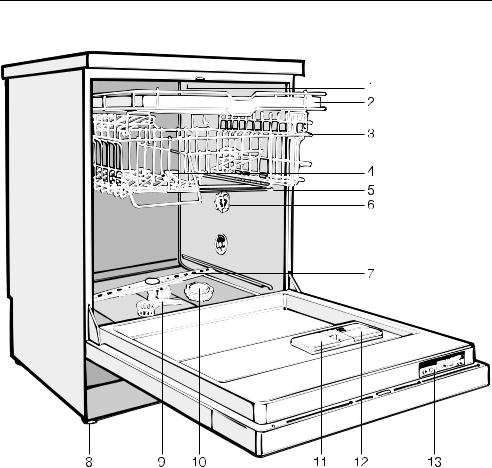
Guide to the appliance
View of the machine
1.Upper spray arm (not visible)
2.Cutlery tray (if applicable)
3.Upper basket
4.Water feed tube for the middle spray arm
5.Middle spray arm
6.Water hardness selector
7.Lower spray arm
8.Four height adjustable levelling legs
9.Combination filter
10.Salt reservoir (if applicable)
11.Dual compartment detergent dispenser
12.Rinse aid reservoir (with dosage selector)
13.Data plate
Note:
Cutlery and lower baskets not shown.
6
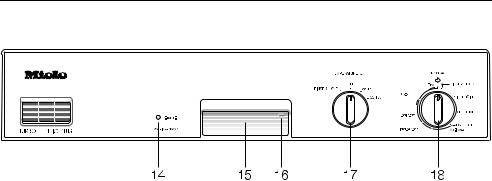
Guide to the appliance
Control panel
14.Rinse aid indicator lamp
15.Door release
16.Child safety lock
17.Temperature selector
18.Program selector knob
7

IMPORTANT SAFETY INSTRUCTIONS
WARNING
When using your dishwasher, follow all basic safety precautions.
This appliance conforms to all uniform safety codes and regulations. To avoid injury and machine damage, read the operating instructions carefully before using the dishwasher.
This dishwasher is designed for household use only.
The manufacturer cannot be held responsible for damage or injury caused by improper use or for uses other than those for which the appliance is intended.
Repairs should only be performed by qualified personnel. Disconnect
the appliance from the power supply before servicing (pull out the plug or turn off the circuit breaker).
If not purchased specifically as a “Freestanding” model, only install
the dishwasher under a continuous countertop which is secured to the cabinetry.
The dishwasher must be electrically grounded. Install the dish-
washer as per the included Installation instructions.
Use only powder detergents and liquid rinse aids recommended for
dishwashers. Never use gels or liquid detergents.
Do not use commercial or industrial grade detergents, as these
may cause adverse chemical reactions and damage the machine. Use only detergents made for residential dishwashers.
Do not use your dishwasher unless all enclosure panels are properly in
place.
Do not allow children to play in or on the dishwasher.
Keep all detergents and rinse aids out of the reach of children.
Dishwasher detergents contain Sodium Silicate and Sodium Carbo-
nate. In case of eye contact, immediately flush with water. Call a physician or poison control.
Do not tamper with the controls.
8

IMPORTANT SAFETY INSTRUCTIONS
When loading items to be washed:
–Load pointed items so that they are not likely to damage the door seal.
–Load knives with the cutting edge down to reduce the risk of injuries.
Do not wash plastic items unless they are labeled “dishwasher safe”
or the equivalent. For items not labeled, check the manufacturer’s recommendations.
Do not abuse, sit, or stand on the door or dishracks of the dish-
washer.
Remove the front door and cut off the power cord of the dishwasher before removing it from service or discarding it. This will help protect children from injury or accidentally locking
themselves in.
Under certain conditions, hydrogen gas may be produced in a
hot water system that has not been used for two weeks or more. HYDROGEN GAS IS EXPLOSIVE. If the hot water system has not been used for such a period, turn on all hot water faucets and let the water flow from each for several minutes before using the dishwasher. This will release any accumulated hydrogen gas. Do not smoke or use an open flame during this time.
Do not drink the water from the wash cabinet.
For dishwashers with visible heating element
Do not touch the heating element during or immediately after use.
SAVE THESE INSTRUCTIONS
9

INSTRUCTIONS IMPORTANTES SUR LA SÉCURITÉ
AVERTISSEMENT
Au moment d’utiliser votre lave-vais- selle, veuillez observer toutes les mesures de sécurité de base.
Cet appareil électroménager est conforme à tous les règlements et codes sur la sécurité. Pour éviter de vous blesser et d’endommager l’appareil, veuillez lire soigneusement les instructions sur l’utilisation.
N’utilisez le lave-vaiselle que pour laver la vaiselle.
Le fabricant ne peut être tenu responsable des dommages ou blessures causés par une utilisation inadéquate ou par des utilisations autres que celles auxquelles l’appareil est destiné.
Les réparations doivent être effectuées uniquement par une per-
sonne compétente. Débrancher l’appareil de la prise de courant avant d’en faire l’entretien (enlever la fiche de la prise ou fermer le disjoncteur).
Installer uniquement le lave-vais- selle sous un comptoir continu qui
est fixé à des meubles adjacents.
Vous devez mettre le lave-vaisselle à la terre. Installer le lave-vaisselle
en observant les instructions pour l’installation ci-jointes.
Utiliser uniquement des détersifs et des produits de rinçage recom-
mandés pour les lave-vaisselle.
Ne pas utiliser de détersifs de qualité commerciale ou industrielle
puisqu’ils pourraient causer des réactions chimiques défavorables et endommager l’appareil. Utiliser des détersifs pour les lave-vaisselle ménagers seulement.
Ne pas utiliser votre lave-vaisselle à moins que tous les panneaux
soient bien en place.
Ne pas permettre aux enfants de jouer dans ou sur le lave-vaisselle.
Ranger tous les détersifs et produits de rinçage hors de la portée
des enfants.
Les détersifs pour lave-vaisselle contiennent du silicate de soude et
du carbonate de soude. En cas de contact avec les yeux, les rincer immédiatement à grande eau. Téléphoner à un médecin ou à un centre de traitement antipoison.
10

INSTRUCTIONS IMPORTANTES SUR LA SÉCURITÉ
Ne pas modifier les commandes.
Ne pas boire l’eau du meuble de lavage.
Au moment de remplir le lave-vais- selle :
–Mettre les articles pointus de manière à ce qu’ils n’endommagent pas le seau étanche de la porte.
–Mettre le tranchant des couteaux vers le bas afin de réduire les risques de blessure.
Ne pas laver les articles en plastique à moins qu’ils n’indiquent “Va
au lave-vaisselle” ou l’équivalent. Vérifier les recommandations du fabricant pour les articles non étiquetés.
Ne pas abuser et ne pas vous asseoir ni vous tenir sur la porte ou
sur les paniers du lave-vaisselle.
Enlever la porte et débrancher le lave-vaisselle avant de le faire rép-
arer ou de le jeter afin d’empêcher les enfants de se blesser ou de s’enfermer dans l’appareil par accident.
Dans certaines conditions, un système d’eau chaude qui n’a pas été
utilisé pendant plus de 2 semaines peut dégager de l’azote.
L’AZOTE EST EXPLOSIF. Si le système d’eau chaude n’a pas été utilisé pendant une telle période de temps, ouvrir tous les robinets d’eau chaude et laisser l’eau couler pendant plusieurs minutes avant d’utiliser le lave-vais- selle. Ceci dissipera tout l’azote accumulé. Ne pas fumer ni utiliser une flamme nue durant ce temps.
Lave-vaiselle avec l’élément chauffant
Ne touchez pas l’élément chauffant pendant le fonctionnement de
l’appareil ou immédiatement après.
CONSERVER CES INSTRUCTIONS
11

Caring for the environment
Disposal of the packing material.
The cardboard box and packing material protects the appliance during shipping. It has been deliberately designed to be biodegradable and recyclable. Please dispose of these materials as you would any other recyclable products.
Disposal of your old machine.
Old machines contain materials which can be recycled. Please contact your local recycling center about the possibility of recycling these materials. Make certain the machine has been made child resistant as outlined in the “Important safety instuctions” before disposing of the appliance.
Energy saving washing.
These dishwashers are exceptionally efficient in their use of water and electricity. You can make the most of your appliance by following these tips:
Make full use of the baskets without overloading the dishwasher for the most economical washing.
Choose a program that best suits the degree of soiling and the type of dishes being washed.
If the baskets are only half full, use the ECONOMY program.
Use the correct amounts of detergent and rinse aid.
12

Before using for the first time
Before using for the first time, please note the following points.
Setting the water softener (if applicable).
The water softener must be set to correspond to the water hardness in your area. This can be obtained from your local water company, or by using a test kit that can be purchased from the Miele Parts Department.
The salt reservoir must only be filled with water and salt. Never fill it with detergent.
Adding rinse aid.
Inadvertently filling the rinse aid reservoir with liquid or powder detergent will damage the reservoir.
Use only powder detergents and liquid rinse aids formulated for domestic dishwashers.
It is important to choose the correct program.
Different wash programs should be selected for different loads and different degrees of soiling. See the program chart for further program descriptions.
Add the correct amount of detergent.
Generally, one to two tablespoons of detergent will be adequate for most wash loads. Not enough or too much detergent can lead to poor wash results.
Cleaning results vary between detergents. If you are not satisfied with the results from one brand, try another quality brand before contacting the Miele Service Department for advice.
Load the dishes correctly.
Load the dishes so that water can contact all surfaces. Ensure that the spray arms are not blocked by items which are too tall for the basket or which extend through the bottom of the basket. If necessary, manually rotate the spray arms to test for clearance.
The combination filter in the base of the wash cabinet and the spray arms must be kept clean.
These should be regularly inspected and cleaned, if necessary.
See the corresponding chapters for detailed information on the above points.
13

Opening and closing the door
To open the door.
Press the release catch inside the door grip.
If the door is opened during operation, all functions will automatically be interrupted.
To close the door.
Push the baskets in.
Lift the door and push until it clicks into position.
Child safety lock.
The child safety lock is designed to deter children from opening the dishwasher door.
Use the provided key to turn the child safety lock to the desired setting.
Horizontal setting = The door is locked.
Vertical setting = the door can be opened.
14
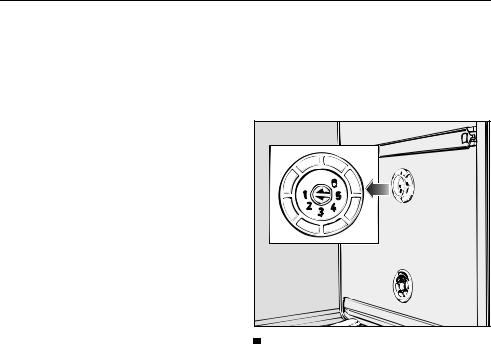
Water softener (Not available in US models.)
The water softener must be set to correspond to the water hardness in your area. This can be obtained from your local water company or by using a test kit that can be purchased from the Miele Parts Department.
Note:
If the water hardness in your area is under 7 gr/gal, it is not necessary to reactivate the softener with salt.
To avoid the build up of calcium deposits on dishes, cutlery, and in the dishwasher, the water should be softened if it is harder than 7 gr/gal.
The dishwasher is factory set for a hardness level of 4 - 14 gr/gal. If your water is harder or softer, this setting will need to be adjusted.
To ensure a steady supply of softened water, the built in water softener must be:
1.Correctly set.
2.Reactivated with salt when depleted.
Setting the water hardness level.
There are six settings on the selector, located on the right side of the wash cabinet:
Using a screwdriver, adjust the water hardness level by turning the selector switch to the appropriate setting.
Setting |
gr/gal |
ppm |
°f |
|
|
|
|
1* |
4-14 |
70250 |
7- 25 |
2 |
15-21 |
270380 |
2738 |
3 |
22-35 |
400630 |
4063 |
4 |
36-47 |
650850 |
6585 |
5 |
48-65 |
860-1170 |
86-117 |
6 |
66-70 |
1190-1260 |
119-126 |
|
|
|
|
*) factory setting
Example:
The water hardness is 340 ppm. The water hardness switch should be set to position 2.
15
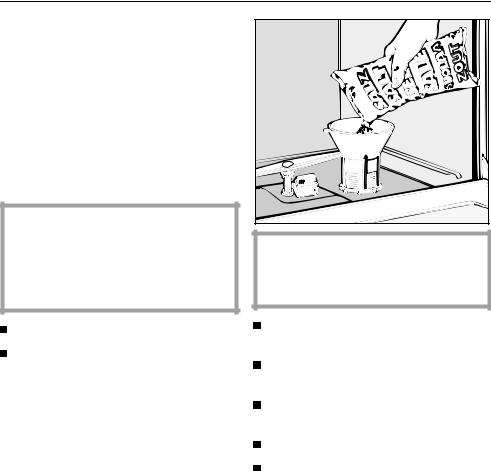
Water softener (Not available in US models.)
Filling the salt reservoir.
The salt reservoir should be filled before the first use and whenever the “Salt” indicator lamp is lit. Use water softener reactivation salt (1 - 4 mm grain size), as other salts may contain insoluble additives which can impair the functioning of the softener.
The salt reservoir holds approx. 4 lbs (2 kg) of salt.
Inadvertently filling the salt reservoir with dishwashing detergent will damage the water softener. Make sure that only water softener reactivation salt of the proper grain size is used.
Remove the lower basket.
Unscrew and remove the salt reservoir cap.
Before filling the salt reservoir for the first time:
Fill the salt reservoir with approximately 2 quarts of water.
Place the funnel (provided) over the salt reservoir.
Carefully fill with salt. As it is filled, water will run out.
Clean any excess salt from the threads of the reservoir opening.
Screw the cap on firmly.
If the dishwasher will not be used immediately after reactivation, run the RINSE & HOLD program. This will remove any traces of salt from the cabinet.
16
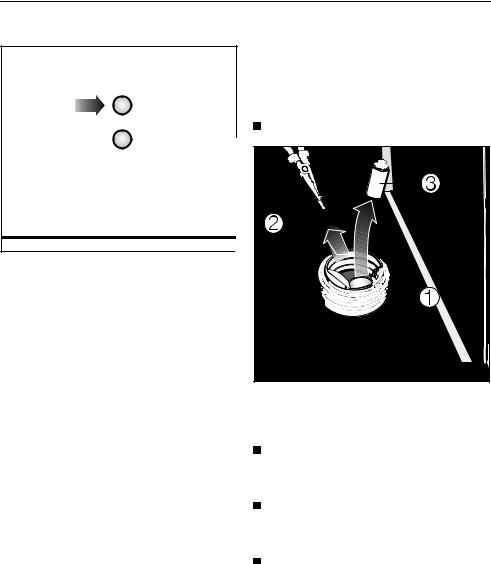
Water softener (Not available in US models.)
Salt indicator.
When the salt reservoir is empty, the “Salt” indicator lamp will light, notifying you that the reservoir should be refilled with reactivation salt.
Note:
If your water is very soft (below
7 gr/gal), the salt indicator lamp will stay on. In this case the reservoir should not be filled with salt. The indicator lamp will remain lit and can be disregarded or bypassed.
Bypassing the Salt indicator lamp.
In order to bypass the salt indicator lamp, you will need a screwdriver and needle nose pliers.
Remove the salt reservoir cap.
Looking into the salt reservoir, you will see the top of the float chamber on the
right hand side b.
Using a screwdriver, carefully pivot the float chamber towards the center of the reservoir.
Using the needle nose pliers, first pull the cap c off of the float chamber, then remove the float d.
Replace the float chamber cap, push the chamber back into its upright position, and replace the salt reservoir cap. The indicator lamp should now remain off.
17
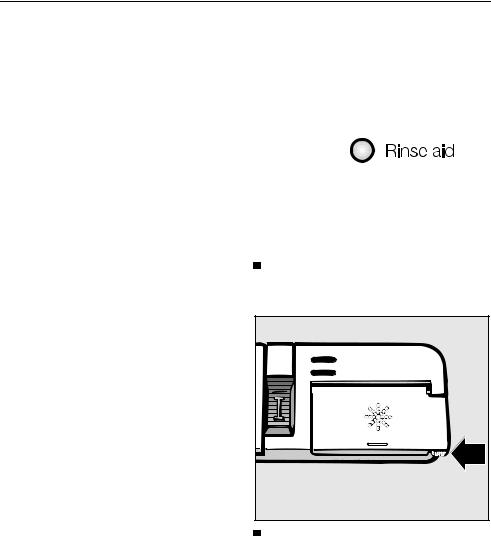
Adding rinse aid
The use of Rinse Aid is recommended |
Adding rinse aid. |
||||
to prevent spotting on dishes and glass- |
|
|
|
||
ware that normally occurs during the |
|
|
|
||
|
|
|
|||
drying phase of automatic dishwashing. |
|
|
|
||
|
|
|
|
|
|
|
|
|
|
|
|
|
Inadvertently filling the rinse aid |
|
|
|
|
|
reservoir with detergent will always |
|
|
|
|
|
damage the reservoir. Only pour liq- |
|
|
|
|
|
|
|
|
|
|
|
uid rinse aid formulated for residen- |
|
|
|
|
|
tial dishwashers into the reservoir. |
|
|
|
|
|
|
|
|
|
|
|
|
|
|
|
|
|
|
|
|
|
|
|
|
|
|
|
|
Add Rinse Aid before the first use and anytime the “Rinse Aid” indicator lamp comes on.
Press the button in the direction of the arrow until the flap springs open.
18
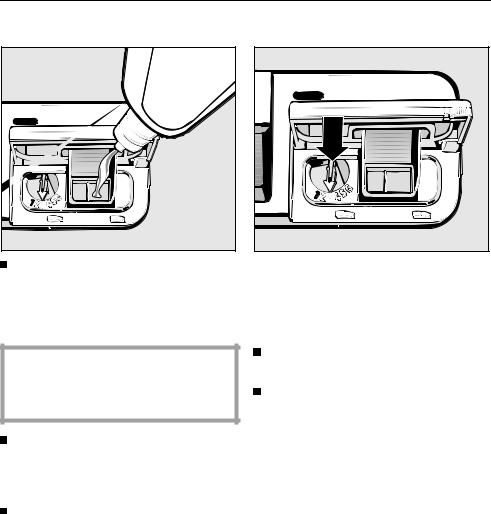
Adding rinse aid
Setting the dosage.
Pour liquid rinse aid into the storage container until it is visible on the surface of the screen. Do not refill until the “Rinse aid” indicator lamp comes on.
Only use rinse aid specifically labeled for residential dishwashers. Inadvertently adding detergent will damage the rinse aid dispenser.
Press on the flap until you hear it click shut. Failure to close it all the way will allow water to enter the reservoir during the wash program.
Wipe up any spilled rinse aid.
The flap will remain closed during normal operation.
The dosage selector comes factory set to 3. It can be adjusted from 1 to 6, depending on your requirements. This setting dispenses approximately 3 ml rinse aid per program.
Use a higher setting if spots appear on dry glassware.
If streaking appears on dishes or glasses, use a lower setting.
19

Loading the dishwasher
Load the dishes so that water can reach all surfaces.
Do not place dishes and cutlery inside other pieces where they may be concealed.
Hollow items such as cups and glasses should be inverted and placed in the upper basket.
Concave based items should be placed at an angle so that water can run off them freely, or placed on top of the coffee bar (See page 25).
Tall, narrow, hollow pieces should be placed in the center of the basket, rather than in the corners, to ensure adequate water coverage.
Small cups and glasses should be placed on the cup racks. Taller mugs and glasses can be placed underneath the rack.
The spray arms must not be blocked by items which are too tall or hang through the baskets. If in doubt, test for free movement by manually rotating the spray arms.
Some food items may contain natural dyes that can discolor plastic items in the dishwasher ( e.g. carrots, tomatoes, ketchup, etc.). The stability of plastic items is not affected by this discoloration.
Some loading examples are shown on the following pages.
In areas where the water has high mineral content, it may be necessary to polish silverware after washing to achieve a high shine.
20
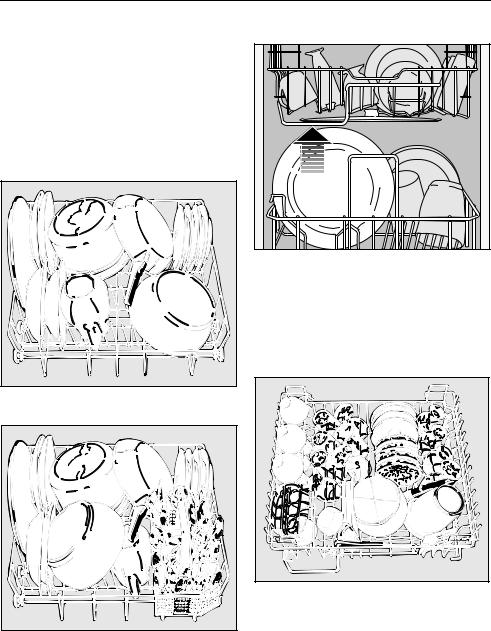
Loading the dishwasher
Loading examples.
Bottom basket.
For larger and heavier items such as plates, serving platters, saucepans, and bowls. Depending on the dishwasher model, glasses can be cleaned in the bottom basket if a special glassware insert is installed.
Dishwashers with cutlery tray.
Dishwashers with cutlery basket.
Height limit
The height guard at the base of the upper basket is there to protect the middle spray arm. No object placed in the lower basket should stand higher than this guard.
Upper basket.
For small, lightweight, delicate items such as cups, saucers, glasses, dessert bowls, etc.
21
